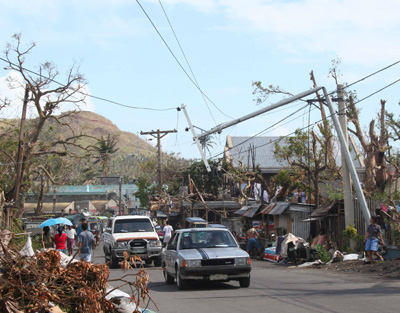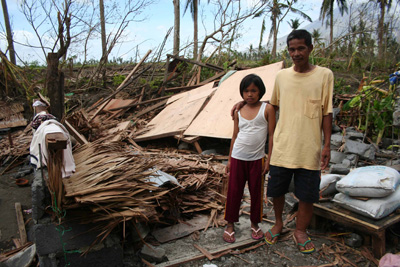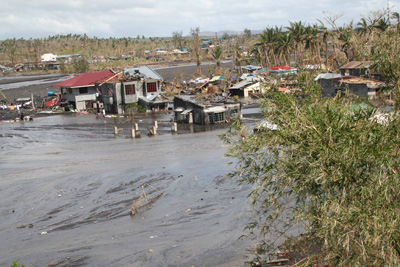
DAVID ADAMS reports on efforts to alleviate the crisis in the Philippines in the wake of Typhoon Durian…
It was just one of the more than 20 typhoons which usually hit the Bicol region of the Philippines every year. But the devastation Typhoon Durian left behind was breath-taking in its scale.



SCENES OF DEVASTATION: Images from the Bicol region in the Philippines taken after Typhoon Durian devastated the area on 30th November, 2006.
“Even before the typhoon, Compassion families had barely eked out a living here as farmers and laborers, bringing home less than $US2 a day to support their families. Poverty meant they had little. Typhoon Durian left them with nothing.”
– Compassion worker Edwin Estioko.
Striking the region located a few hundred kilometres south of Manila late last month, it brought with it widespread destruction. Landslides originating at the nearby volcano Mayon buried several entire communities and left a death toll expected to reach well beyond 1,000 people in what some have described as the worst natural disaster to hit the country since the eruption of Mt Pinatubo in 1991.
Edwin Estioko is a communications and education specialist with child-focused Christian agency Compassion.
“Your eyes cannot rest to see a spot where there are no fallen trees, broken electric posts, destroyed houses, and debris scattered on the streets,” he says, describing the scene left in the wake of the typhoon.
“Evenings are very dark and humid since the whole Bicol region is without electricity. Telephones lines are also cut. Villages that were within the proximity of Mayon’s mudflow were covered roof-high, about 10 feet. They have turned into deserts of mud and huge boulders. Roofs on where the houses used to stand and coconut tree tops shoot out from the mud and lahar. These areas also give out a strong stench that hint corpses still buried underneath. Many people are digging up their homes hoping to salvage any possessions.”
The statistics say it all. Ninety per cent of houses, schools and agricultural properties were damaged in the disaster with almost 40,000 homes totally destroyed and another 108,000 partially damaged. As many as 250,000 families were affected with more than 4000 now living in evacuation centres.
It’s two weeks since the typhoon stuck the area and Estioko says that while relief goods and medical supplies continue to arrive from both government and non-government sources from both within and outside the Philippines – including organisations like World Vision, Operation Blessing and the Red Cross, the levels of aid in the area are still not yet sufficient.
He says the most immediate needs in the area are for medicines, professional medical assistance (most of those initially responding were volunteer student nurses and teachers), trauma counselling and for basic necessities, such as food, clean water, clothes, bedding and tarpaulins.
Compassion’s initial response (the organisation, which has connections with more than 34,000 children across the Philippines, including 1,341 living in the affected area, says that thankfully none of these children was killed, hurt of missing in the disaster) included liaising with partner churches who checked on children and their families and opened their churches to welcome evacuees.
The organisation has since provided food to affected families, organised a professional medical team of five doctors to visit the area and mobilised scores of volunteers. It is now working to provide temporary shelters for some of the affected families, trauma counselling and is establishing ‘child friendly’ tents where children can resume their developmental activities.
While noting that it’s expected to take at least two years for the region to rebuild – with electricity alone not expected to be restored before six months, Estioko says that the Filipino people in the area have responded with hope.
“The Filipinos are a beautiful people because we are very pliable like the bamboo,” he says. “Like the bamboo we can bend way down when battered by storm but slowly stand back up afterwards. This is proven true as most of the volunteers in our church partners are the victims themselves.”
Estioko says that while the poor of the region have been made even more so in the wake of the typhoon, “Filipino families are holding on, praying to God, and waiting for help so that soon – perhaps in a year or two – they could rebuild their homes, send the children back to school, and pick up from where the typhoon left them”.
“Even before the typhoon, Compassion families had barely eked out a living here as farmers and laborers, bringing home less than $US2 a day to support their families. Poverty meant they had little. Typhoon Durian left them with nothing.”
Estioko says that now is a good time for Compassion sponsors in countries like Australia to write to their sponsored children if they are in the affected area.
“I pray that your people will respond by remembering our countrymen in prayers and extending material help as well,” he says.
Asked what people in nations like Australia can be praying for with regard to the situation, Estioko says: “Please pray that our people will always turn to God in times like these. Pray for our church partners and other churches in the area to rise above the crisis so that their faith in our Lord will shine above their damped condition and people will turn to Him.”
He urges people to pray that Compassion has enough funds to not only provide food for the affected families, but also to provide children with “safe and blissful spaces once again where they can come together to study God’s Word, play, and be happy children”.
“Until such time – until Compassion builds those child-friendly tents, let us pray for their safety, protection, and health,” he says.
“Let us also pray for wise and Spirit-filled counsellors so that the victims could truly be set free from trauma (and)…for comfort to all the sponsors around the world, including those in Australia whose sponsored children have been affected.”
To donate to Compassion Australia’s Disaster Relief Fund for the Philippines please go to www.compassion.com.auor call 1800 224 453.





